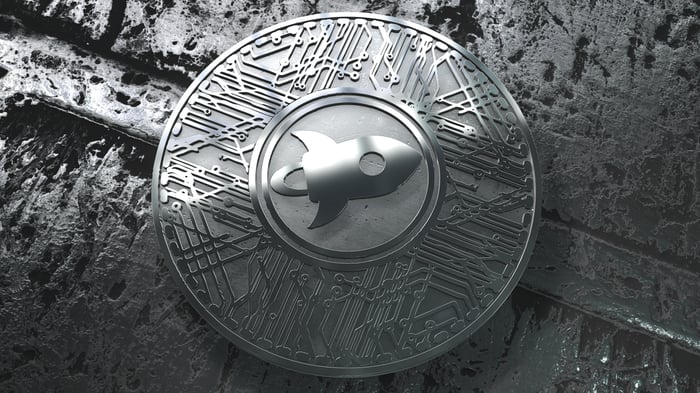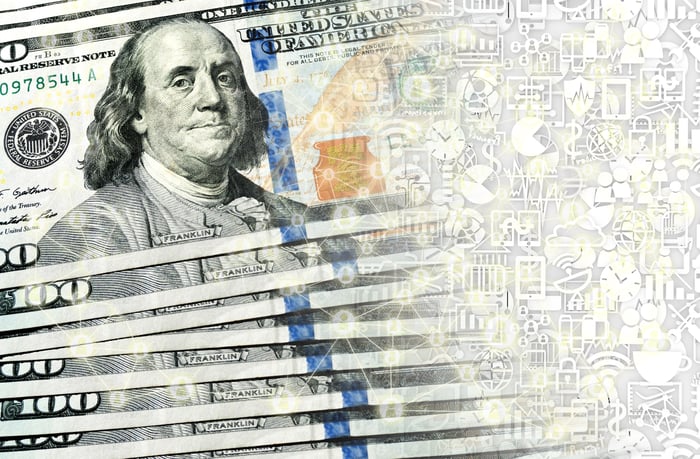Dating back to the late 1800s, the stock market has reigned supreme. Even though other asset classes have had their moment in the sun, such as housing in the 2000s, no investment vehicle has delivered higher average annual returns over the very long run.
But over the short term, it’s a very different story.

The Shiba Inu dog breed has inspired big gains for crypto investors. Image source: Getty Images.
Shiba Inu has gained more than 13,200,000%!
For the past couple of years, dozens of widely followed cryptocurrencies have lapped the broader market many times over. Leading that charge is ultra-popular meme coin, Shiba Inu (CRYPTO:SHIB).
As of late evening on Nov. 2, a single SHIB token would set an investor back $0.00006738. That’s close to seven thousandths of one penny! Yet it’s a far cry from where Shiba Inu traded on its debut day back at the beginning of August 2020 ($0.00000000051). In just a shade over 15 months, SHIB tokens have gained 13,211,665%. If you invested $10 on Aug. 1, 2020, and held, you’re now a millionaire.
Shiba Inu’s historic gain is the result of multiple factors:
- A growing number of cryptocurrency exchanges are listing SHIB tokens for trade, which is increasing awareness and building up the community.
- The launch of decentralized exchange ShibaSwap in July allows investors to stake their tokens and more importantly encourages them to hold SHIB for a longer period of time.
- Elon Musk’s tweets are fueling gains. Even though Musk doesn’t own Shiba Inu coins, he did recently adopt a Shiba Inu puppy named Floki. Anytime Musk tweets about his dog or the breed, investors pile into SHIB.
- With few avenues to bet against Shiba Inu, there’s a clear emotion-driven buy bias fueling this run.

Image source: Getty Images.
SHIB’s dream run will eventually implode
But on the flipside, there are a laundry list of reasons to believe Shiba Inu will implode. For example, SHIB has virtually no use outside of a cryptocurrency exchange. You’d think the ninth largest cryptocurrency by market cap would be accepted by more than roughly 100 businesses, but that’s just not the case.
Shiba Inu also fails the sniff test when it comes to competitive advantages. This is to say that Shiba Inu doesn’t stand out when it comes to its ability to process transactions. It’s not even the only successful cryptocurrency to have adopted its inspiration from the Japanese Shiba Inu dog breed (Dogecoin did it, too).
To add, Shiba Inu is constantly being diluted by other blockchain projects. According to CoinMarketCap.com, there are around 13,500 cryptocurrencies, and this number is growing rapidly. To be blunt, there are far more-efficient and/or cheaper payment coin options than Shiba Inu.
Even history says Shiba Inu is in big trouble. Other payment coins that have had five-and-six-digit percentage runs higher all eventually lost more than 90% of their value.

Image source: Getty Images.
These cryptocurrencies have a much brighter future than Shiba Inu
Even as a cryptocurrency skeptic, I see far more potential and a brighter future for the following five digital currencies, relative to Shiba Inu.
Ethereum
Ethereum (CRYPTO:ETH) is unquestionably the most-established cryptocurrency on this list, and also the one generating the most real-world buzz. That’s because Ethereum’s blockchain is the backbone of decentralized finance (DeFi). DeFi uses smart contracts on financially focused blockchain to complete transactions that might otherwise be slowed down or halted by financial institutions. These smart contracts, which are protocols designed to verify, enforce, and facilitate an agreement between two parties, are the heart and soul of what drives Ethereum.
In terms of real utility, the Enterprise Ethereum Alliance (EEA) has more than 100 members, all of which are aiming to increase knowledge and use of Ethereum’s blockchain. While we often think of blockchain in terms of its ability to speed up financial transactions (especially cross-border payments), it has logistical applications, too. Quite a few of the EEA members’ supply chain would benefit from Ethereum’s blockchain technology.

Image source: Getty Images.
Stellar
Blockchain-based payment network Stellar (CRYPTO:XLM) is another cryptocurrency this skeptic believes has a future.
Using today’s infrastructure, cross-border payments can take up to a week to validate and settle. With Stellar, fiat currency can be converted to Lumens (XLM, the protocol token of the network), transferred halfway around the world, and converted back to native fiat currency in a matter of seconds. The cost to complete the transaction? Just 0.00001 XLM, which works out to $0.0000038 per transaction. It takes more than 263,000 transactions just to rack up $1 in fees.
Aside from rapid, low-cost execution, Stellar has also had some real-world run. It worked with IBM to test its cross-border payments platform with a dozen banks in the South Pacific region in 2017. It’s also part of collaboration with Visa and Tala to bring financial blockchain solutions to emerging markets where access to basic financial services is limited.

Image source: Getty Images.
Solana
Another digital currency with superior potential to Shiba Inu over the long-term is Solana (CRYPTO:SOL).
Like Ethereum, the Solana blockchain is all about incorporating smart contracts and allowing developers to build decentralized applications (dApp). But unlike Ethereum, Solana brings a number of notable advantages to the table on the efficiency front. Solana’s proof-of-history protocol, which establishes events as true without requiring validators to talk to each other, dramatically improves the speed by which transactions process. Whereas Ethereum processes around 13 transactions per second, Solana can handle 50,000 or more transactions per second.
Similarly, Solana looks to have an edge on Ethereum from a fee standpoint. When Ethereum’s network gets bogged down with transactions, the fees associated with payments can soar. With Solana, the fees are often around $0.00025 per transaction. This means it’d take approximately 4,000 transactions to reach a mere $1 in fees. If this efficiency holds true as the network scales, Solana can carve out a healthy share of dApp demand next to Ethereum.

Image source: Getty Images.
Nano
For something completely off the radar, look for Nano (CRYPTO:NANO) to completely outperform Shiba Inu over the long run. Nano is the 117th-largest digital currency by market cap ($820 million, as of Nov. 2).
The purpose of financially focused blockchain is to speed up payment settlement times, dramatically reduce costs, and democratize the process to allow everyone to participate. This is precisely what Nano does with its block-lattice blockchain. Rather than having a single blockchain, every user on Nano has their own blockchain they can add to without having to compete with other users. This makes Nano’s network scalable and highly efficient — the average transaction is completed in under a second.
Something else that stands out is Nano’s fee-less transactions. Nano’s consensus mechanism, Open Representative Voting (ORV), allows representatives to vote on the validity of individual blocks on the network. ORV provides differentiation, and more importantly keeps transactions free.

Image source: Getty Images.
Cardano
Last, but certainly not least, Cardano (CRYPTO:ADA) looks to have a much brighter future than Shiba Inu.
Although Cardano has experienced development delays (what major blockchain project hasn’t?), its developers have laid out a clear vision of the steps they’ll be taking to improve and grow the network. In the summer of 2020, the Shelley upgrade was released, which increased the number of nodes network participants could run. Following Shelley, the number of transactions on Cardano’s blockchain have increased from around 2,000 per day to more than 100,000 per day.
In September 2021, the much-anticipated Goguen update was unveiled. Goguen unleashes smart contracts on Cardano’s network, which paves the way for financial and nonfinancial dApps.
Assuming Cardano’s network can be significantly scaled and kept secure, which is what developers are working on now, it could be a serious rival to Ethereum and Solana.
This article represents the opinion of the writer, who may disagree with the “official” recommendation position of a Motley Fool premium advisory service. We’re motley! Questioning an investing thesis — even one of our own — helps us all think critically about investing and make decisions that help us become smarter, happier, and richer.
